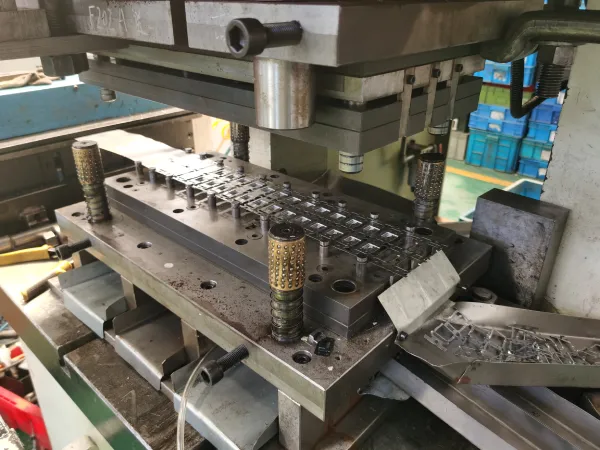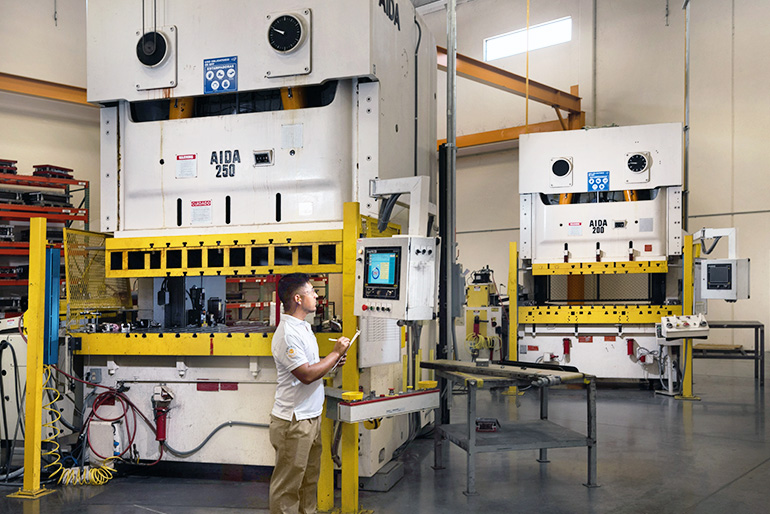Metal Stamping Procedures: From Prototyping to Mass Production
Metal Stamping Procedures: From Prototyping to Mass Production
Blog Article
The Evolution of Steel Marking Processes: Innovations and Applications
The world of steel marking procedures has observed a transformative journey noted by continuous innovation and adaptation to fulfill the needs of modern-day industrial techniques. From the conventional techniques deeply rooted in history to the sophisticated innovations driving high-speed accuracy, the development of steel stamping has been absolutely nothing short of exceptional. As brand-new tooling methods and automation discover their means into this industry, the implications for effectiveness and top quality are extensive. The applications extend across a spectrum of markets, each benefiting uniquely from the improvements in steel marking processes.
Typical Metal Stamping Methods
Traditional metal stamping techniques have long been the foundation of making processes in numerous industries as a result of their effectiveness and precision. The procedure includes creating a metal sheet or coil right into a wanted form by pressing it in between a die and a punch. This approach is widely utilized for creating large quantities of get rid of high accuracy at a fast rate.
One of the vital advantages of standard metal marking methods is the capacity to keep limited resistances, ensuring that each part fulfills the required specs continually. This level of accuracy is essential in markets such as auto, aerospace, and electronic devices, where also minor variances can result in significant problems.
Furthermore, typical metal stamping strategies offer affordable services for automation compared to other making techniques. The capacity to mark parts in fast succession lessens manufacturing time and decreases labor expenses, making it an attractive option for organizations seeking to optimize their production procedures.
Appearance of High-Speed Stamping

One of the crucial benefits of high-speed stamping is its ability to maintain precision and consistency even at sped up processing rates. This accuracy is crucial in markets where limited resistances and elaborate layouts are needed. In addition, high-speed marking permits the handling of a vast array of materials, including light weight aluminum, stainless steel, and copper, further expanding its applicability throughout numerous fields.
Additionally, the introduction of high-speed marking has actually allowed makers to fulfill the expanding demand for complex parts in sectors such as automotive, aerospace, and electronic devices (Metal Stamping). By leveraging the speed and precision of high-speed marking technology, firms can boost their competitiveness in a rapidly developing market landscape
Developments in Tooling Innovation
With the development of high-speed marking enabling improved accuracy and performance in metal developing processes, the area of steel stamping has actually seen substantial developments in tooling technology. Tooling modern technology plays a critical function in steel stamping operations, affecting factors such as item top quality, production speed, and overall cost-effectiveness.
Moreover, developments in materials scientific research have actually caused the production of tooling products with enhanced resilience, use resistance, and thermal conductivity. By utilizing these advanced products, tooling manufacturers can create my site passes away and mold and mildews that withstand the high stress and temperature levels associated with steel stamping procedures, causing longer device life and better production efficiency. In addition, innovations in device layout, such as the usage of simulation software program and additive manufacturing strategies, have actually enabled the production of intricate tooling geometries that were formerly challenging to produce. On the whole, these improvements in tooling modern technology have actually revolutionized the steel stamping industry, permitting producers to achieve higher levels of precision, productivity, and price savings.
Assimilation of Automation in Stamping
As automation continues to reshape the landscape of metal marking procedures, the combination of automated systems has come to be increasingly prevalent in modern manufacturing centers. Automated systems supply many advantages in steel marking, consisting of raised performance, enhanced accuracy, and improved safety and security. By incorporating automation into marking processes, suppliers can minimize cycle times, reduce product waste, and optimize production throughput.
Among the vital components of automation in stamping is using robotic arms for tasks such as material handling, part manipulation, and top quality assessment (Metal Stamping). These robotic systems can execute repetitive and labor-intensive jobs with speed and accuracy, freeing up human drivers to concentrate on even more intricate operations. Furthermore, automation permits real-time surveillance and adjustment of stamping processes, bring about greater total process control and high quality guarantee
In addition, the assimilation of automation in stamping makes it possible for makers to achieve find more info regular component quality, fulfill tight tolerances, and improve overall efficiency. As innovation remains to development, the duty of automation in metal marking procedures is anticipated to broaden even more, driving technology and efficiency in the manufacturing market.
Applications Throughout Diverse Industries
Incorporating metal marking procedures across varied sectors showcases the adaptability and flexibility of this manufacturing strategy. Furthermore, the appliance industry advantages from steel marking procedures to make components for fridges, cleaning machines, and other family appliances. visit here The versatility of steel marking procedures makes it a valuable production method throughout numerous sectors, demonstrating its value in modern-day production processes.
Conclusion

Report this page